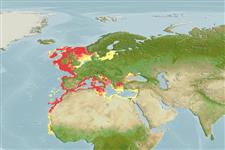Classification / Names
Common names from other countries
Main reference
Size / Weight / Age
Max length : 30.0 cm TL male/unsexed; (Ref. 5377); common length : 13.0 cm SL male/unsexed; (Ref. 4952)
Length at first maturity
Lm 8.2 range ? - ? cm
Environment
Marine; demersal; depth range 40 - 700 m (Ref. 56504)
Climate / Range
Subtropical, preferred 21°C (Ref. 107945); 62°N - 10°N, 18°W - 36°E
Distribution
Eastern Atlantic: western Norway, Skagerrak, Shetlands and western Scotland to Senegal. Also in the Mediterranean (mainly western part).
Countries | FAO areas | Ecosystems | Occurrences | Introductions
Short description
Dorsal
spines
(total): 9 - 10;
Dorsal
soft rays
(total): 23-25;
Anal
spines: 3;
Anal
soft rays: 22 - 24. Eye large; snout as long as eye or longer. Mouth very protractile, forming a short tube when protruded. Third dorsal and anal spines only a little longer and stronger than the others. Body depth more than one and a half times in standard length. Vertebrae 21-23.
IUCN Red List Status (Ref. 115185)
Threat to humans
Harmless
Human uses
Fisheries: of no interest
More information
ReferencesAquacultureAquaculture profileStrainsGeneticsAllele frequenciesHeritabilityDiseasesProcessingMass conversion
Tools
Special reports
Download XML
Internet sources
Estimates of some properties based on models
Phylogenetic diversity index
PD50 = 1.0000 many relatives (e.g. carps) 0.5 - 2.0 few relatives (e.g. lungfishes)
Trophic Level
3.1 ±0.3 se; Based on diet studies.
Resilience
Low, minimum population doubling time 4.5 - 14 years (K=0.145; tmax=26; tm=1.84)
Vulnerability
Moderate to high vulnerability (51 of 100)
Price category
